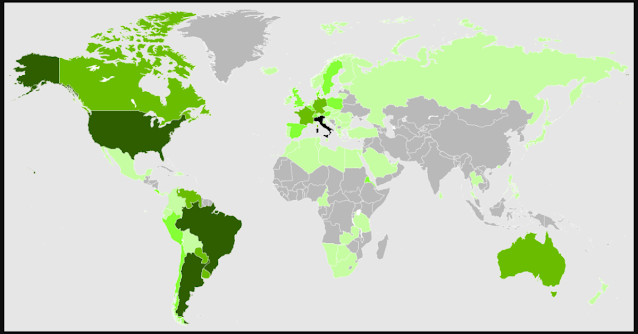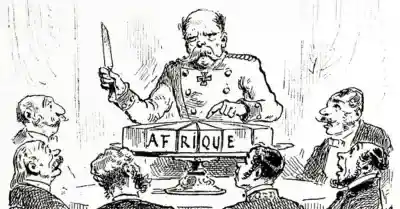The Enduring Impact: Italian Diaspora in Americas
Little Italy is a neighborhood where Italians and people of Italian descent live together, creating a mini Italy within a larger city. It has Italian shops, restaurants, and preserves Italian culture. These enclaves formed due to Italian immigration and are now known for their ethnic charm. These neighborhoods can be found in cities like New York, Chicago, Montreal, Melbourne, Buenos Aires, and many others.
Little Italy in the USA was a vital part of the Italian Diaspora, which took place mainly between the late 19th and early 20th centuries. During this time, millions of Italians left Italy in search of better opportunities in the United States. The Italian diaspora refers to the mass migration of Italians from Italy in two main periods. The first wave started around 1880 due to poverty and overpopulation, pushing Italians to seek better opportunities in the Americas.
The second wave occurred after World War II and ended in the 1970s. In total, about 15 million Italians left Italy between 1880 and 1980. According to the Italian American Studies Association, there are now about 18 million Italian Americans that makes up around 5.4% of all the people in the United States.
This article emphasizes the historical significance of “Little Italy” areas as centers of Italian culture in the USA and the broader context of the Italian Diaspora that led to their creation. It also highlights the ongoing challenges Italy faces due to emigration, particularly the departure of young, educated individuals, and contrasts this with the attention given to external migration.
 |
| Stamp of Brazil Italian Immigration |
💻 Table of Contents:
- Brain Drain: A Global Challenge for Nations
- New York City’s Iconic Little Italy
- Exploring Chicago’s Little Italy: A Taste of Italian Heritage
- Boston’s Little Italy: A Slice of Italian Legacy
- From Italy to Newark: The Italian American Story in New Jersey
- “Little Italy”: Beyond USA Shores
Brain Drain: A Global Challenge for Nations
Currently, there is a third wave known as “Brain Drain” that refers to a significant movement of people, often resulting from political unrest, better job prospects abroad, or the pursuit of a higher quality of life, where people emigrate or migrate away from their home country. It is commonly used as a slang term because choosing to migrate elsewhere in search of a better life, rather than making sacrifices to resolve the issues within one’s own society or country, can be seen as a reflection of the collapse of moral intelligence or self-centeredness.
Internal migration also saw four million people moving from Southern Italy to Northern Italy between the 1950s and 1970s. In 2019, a lot of Italians, especially young and educated people, left their country, with an estimated departure rate much higher than official records. It’s like losing a city the size of Bari every year, mainly consisting of innovative and entrepreneurial young individuals. However, Italian media and politicians seem more focused on migration from outside instead of internal diaspora.
New York City’s Iconic Little Italy:
The majority of Italian immigrants from this era initially arrived on American soil at Ellis Island. In the 1880s, there were 300,000 of them. In the 1890s, that number doubled to 600,000. Over the next ten years, more than two million Italians arrived in the U.S. By 1920, when immigration began to decrease, over 4 million Italians had arrived in the United States. They made up over 10 percent of all the foreign-born individuals in the country. At present, New York State is home to the largest Italian-American population in the United States, with approximately 3.1 million individuals of Italian descent.
 |
| Map of the Italian Diaspora in the World |
“Little Italy” in the USA refers to areas where Italian immigrants and their descendants have fashioned enthusiastic societies. These areas are like a slice of Italy within a larger non-Italian city, featuring Italian shops and restaurants. They developed as Italians settled together during waves of immigration. Several regions and cities across the United States are commonly known as “Little Italy” due to their rich Italian-American heritage and communities. These areas are not only historically significant but also offer a unique glimpse into Italian culture and traditions.
Little Italy, located in Lower Manhattan in New York City, is famous for its Italian population. While it once covered a larger area, it has now diminished and is primarily centered on Mulberry Street north of Canal Street. Little Italy’s origins date back to the late 19th century when Italian immigrants settled there, facing poverty and overcrowding in their homeland.
In its prime, around 1910, Little Italy had nearly 10,000 Italian residents, making it the peak of its Italian population. However, after World War II, many residents began to move to other parts of the city and nearby areas like Brooklyn and New Jersey. The neighborhood also saw an increasing Chinese immigrant population as immigration restrictions were lifted in 1965, and Chinatown expanded southward.
Over the years, it has transitioned into a tourist hub with numerous restaurants, cafes, and cultural events, although the Italian-speaking community has largely moved out. One of the best times to visit is in late September, during the Feast of San Gennaro, when over a million people gather to celebrate Naples’ Patron Saint. The festivities include Italian food vendors, music, parades, and even a cannoli-eating contest.
 |
| Sicilian Family |
But anytime you visit is worthwhile. Don’t miss the historic Ferrara Caffé, known as America’s first espresso bar (a coffee house). This family-owned business has been serving Italian pastries, cookies, cannoli, sfogliatelle, and cappuccino since 1892. Despite its changing demographics, Little Italy remains a historic and vibrant part of New York City.
Exploring Chicago’s Little Italy: A Taste of Italian Heritage
Taylor Street stands as one of Chicago’s most historic regions. From the late 1800s to the 1950s, it served as a vibrant hub for Italian immigrants to build their lives and families, ultimately earning the distinction of being Chicago’s “Official” Little Italy. Known for its lively culture, this place has many real Italian restaurants, bakeries, and shops that offer food just like in Italy. Little Italy in Chicago skillfully blends old traditions with a modern touch, offering a magnetic gateway to Italian flavors in the heart of the city.
Additionally, the district is adorned with Italian specialty stores, markets, and shops, offering imported products, fine wines, and unique artisanal goods. Nearby, the University of Illinois at Chicago plays a vital role in fostering academic and cultural connections with the Italian community, boasting a robust Italian studies program.
 |
| Columbus Day Italian Heritage |
Boston’s Little Italy: A Slice of Italian Legacy
The North End, often called Boston’s “Little Italy,” is a blend of history, Italian culture, and scrumptious cuisine. Home to iconic landmarks like the Paul Revere House and Old North Church, it’s Boston’s oldest residential district. Its quaint streets exude old-world charm, filled with the tempting scents of Italian dishes from local restaurants and bakeries. Must-try spots include Mike’s Pastry and Modern Pastry for mouthwatering cannoli. Beyond food and history, the North End hosts cultural events, like the lively North End Feasts and Festivals in summer.
In 1875, East Boston had few Italians, as it was mainly Irish. But after 1895, Italian immigrants began arriving to escape economic struggles in Italy and overcrowding in Boston’s North End. By 1910, over 4,500 foreign-born Italians lived in East Boston, growing to 10,000 by 1920, representing a significant portion of Boston’s Italian population. While the foreign-born Italian community peaked in the 1920s, subsequent generations of Italian immigrants continued to enrich the Italian-American community in the region for many more decades.
💻 You May Also Like:
- The Geopolitical Connection: Italian Eritrea and the British-Ethiopian Part
- The Age of Exploration: Christopher Columbus and the New World Discovery
- Hispanics in the United States: A Journey of Contributions and Resilience
From Italy to Newark: The Italian American Story in New Jersey
New Jersey boasts a considerable Italian American community, with strongholds in cities such as Newark, Jersey City, and Hoboken. According to the Census, approximately 17 percent of New Jersey’s population, which equates to about 1.5 million individuals, can trace their roots back to Italy.
Italian migration to the United States peaked from about 1880 to 1920, with around four million Italians immigrating during this period, primarily from the southern regions of Italy. Newark’s various Italian communities emerged during that peak years. In 1880, only 407 Italians lived in the city, but by 1910, this number had surged to 20,000, making Newark the fifth-largest American city in terms of Italian population. By 1920, Newark was home to 27,465 Italians who affectionately referred to it as “NEVARCA,” and they settled in various parts of the city.
 |
| Bochas Oliver Family |
As per a recent estimate from the United States Census Bureau, approximately 17.8 million Americans can trace their ancestry back to Italy. Italian American communities took root in numerous major industrial cities during the early 20th century, including New York, Boston, New Jersey, and others.
“Little Italy”: Beyond USA Shores:
Many Italians left Italy in the late 19th and early 20th centuries, which was one of the biggest emigrations in modern history. They went to countries like Argentina, Brazil, the United States, Uruguay, Canada, Venezuela, and Peru. The National Bureau of Economic Research says about 8.9 million Italians went to the Americas, 7.6 million to other European countries, 300,000 to Africa, 42,000 to Oceania, and 13,000 to Asia.
Nowadays, sizable Italian ancestral populations can be found in Brazil (25 million), Argentina (20 million), the US (17.8 million), France (5 million), Venezuela (2 million), Uruguay (1.5 million), Canada (1.4 million), and Australia (800,000). Outside the United States, you can discover “Little Italy” or Italian enclaves in various countries, including:
Argentina:
Italian Argentines are people in Argentina with Italian roots. Many Italians came to Argentina between 1880 and 1930, making it the largest Italian migration. In the late 1800s and well into the 1900s, the La Boca neighborhood in Buenos Aires established itself as the city’s initial “Little Italy.” It’s estimated that around 62.5% of Argentines have some Italian ancestry, making it the second-largest Italian community outside of Italy. Italians, along with the Spanish, played a significant role in shaping Argentine culture, from language to customs. Argentina’s cuisine, fashion, and lifestyle have been heavily influenced by Italian immigration.
Brazil:
Italian Brazilians are people in Brazil who have Italian ancestry. They are the largest group of people with Italian roots outside of Italy. Most of them live in São Paulo, and many are in Espírito Santo. Small towns in southern Brazil, like Nova Veneza, have a lot of Italian descendants.
São Paulo boasts a significant Italian population, with many settling in the neighborhood of Bixiga, often referred to as São Paulo’s “Little Italy.” The national census in Brazil doesn’t ask about people’s ancestry, so we don’t have official numbers. But in 2013, the Italian Embassy in Brazil said there were about 32 million Italian descendants in Brazil, which is about 15% of the population. Half of them are in São Paulo. Italian culture has a big influence on Brazilian culture, including language, customs, and traditions. Brazil also loves Italian things like food, fashion, and lifestyle because of Italian immigration.
Canada:
Little Italy, also called College Street West, is a part of Toronto, Ontario, Canada. People know it for its Italian-Canadian restaurants and shops. This place also has many Latin-Canadian and Portuguese-Canadian residents. Little Italy is mostly around College Street, somewhere between Harbord Street and Dundas Street. It stretches out to the east and west between Bathurst Street and Ossington Avenue. It’s part of a bigger neighborhood known as Palmerston-Little Italy.
Uruguay:
Italian Uruguayans are people in Uruguay who have Italian ancestry. Many of them are Uruguayan citizens, and their ancestors came from Italy during the Italian diaspora. Uruguay has one of the highest percentages of Italians outside of Italy. It’s thought that around 44% of Uruguay’s population, which is roughly 1,500,000 people, have Italian roots. There are also about 90,000 Italian citizens living in Uruguay.
Venezuela:
Italian Venezuelans are people in Venezuela with Italian roots. Many arrived during the Italian
diaspora. Italians were one of the largest European immigrant groups in Venezuela, and about 16% of the country’s population, or roughly 5 million people, have Italian heritage. Italian culture has influenced the country’s accent and diet, making Venezuela the second-largest consumer of pasta per capita worldwide. Additionally, approximately 30,000 Italian citizens live in Venezuela.
 |
| Immigrants from Italy |
Italian Peruvians:
Italian Peruvians are people in Peru with Italian ancestry. Many of them were born in Peru, but their ancestors came from Italy during the Italian diaspora. Italians ranked as the second largest immigrant group to establish themselves in Peru among European Peruvians.
Italian immigration to Peru began during the colonial era, when Peru was part of the Spanish Viceroyalty. However, the largest wave of Italian immigrants came after Peru gained independence, from 1840 to 1880, during a period of economic growth driven by guano exports. More Italians arrived between 1914 and 1950, influenced by the two World Wars and coming from Italy, Argentina, and Brazil. They included merchants, peasants, and technicians who formed families and settled in Peru permanently.
Approximately 500,000 Italian Peruvian descendants make up roughly 1.6% of the total population, making them the second-largest community after the Spanish one.
Conclusion:
In recent decades, Italy has experienced a “Brain Drain” as many highly educated and skilled individuals have emigrated in search of better job prospects and professional opportunities. This emigration of talented individuals can have both positive and negative effects. On the one hand, it can lead to the exchange of ideas, remittances back to Italy, and potential for international trade. On the other hand, it may reduce the country’s growth potential and lead to demographic challenges, particularly in an aging society.
The balance between these forces and the impact of brain drain on Italy’s economy and society is a topic of ongoing study and discussion. It reflects the complexity of Italian migration over time, from the early waves of emigration to the contemporary challenges posed by the brain drain.





